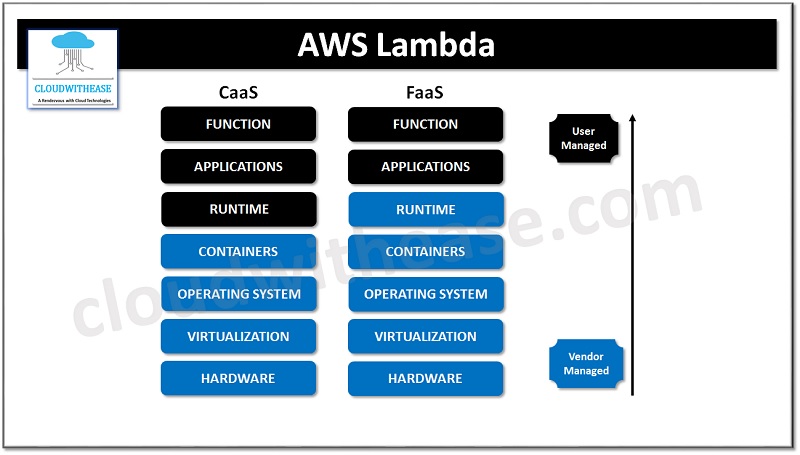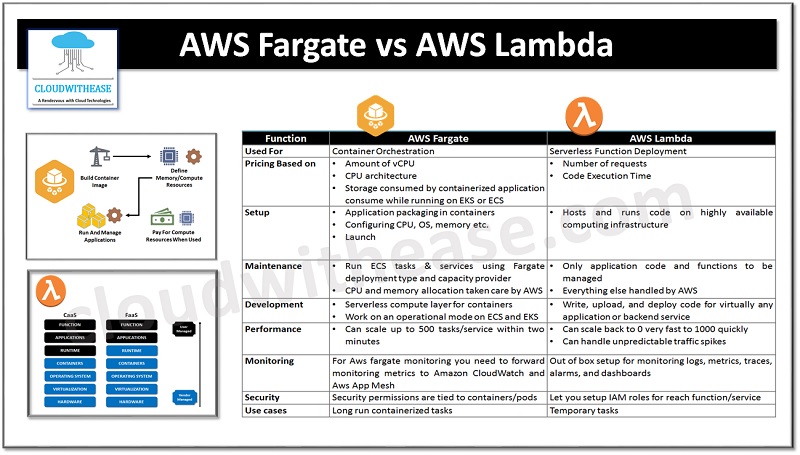Table of Contents
Serverless technologies have taken a pace in the last couple of years due to advent and increasing penetration of cloud computing. The serverless technologies reduce the overhead of operations management and let you use infrastructure on a pay per use model with no upfront cost. However, there could be differences in their functions. Fargate Container as a service (CaaS) and Lambda Function as a service (FaaS) are two such distinct serverless technologies.
Today we look more in detail about two most prominent serverless technologies – AWS fargate and AWS Lambda, key differences between them, features and use cases.
What is AWS Fargate?
AWS Fargate is a serverless compute which enables focus on container tasks, such as establishing access controls and resource parameters and eliminate more time-consuming tasks such as provisioning, management, scaling, updating, securing clusters of Elastic Compute cloud (EC2) servers and virtual machines.
It handles many tasks on your behalf such as patching, scaling instances etc. primary focus is to optimize code for delivery and enables Fargate as container-as-a-service offering.

Features of AWS Fargate
Some of the key features of AWS Fargate
- Developers can build locally using docker and run container images directly from cloud
- No operational overheads of patching, scaling, management and securing infrastructure all taken care by AWS
- Packages applications in the form of containers
What is AWS Lambda?
In the year 2020 Amazon enabled AWS Lambda to package and deploy functions as container images instead of packaging all functions code and its dependencies as a single .zip file. It is an event driven compute engine and a serverless technology as AWS Fargate.
It helps in reduction of operational overhead of managing the infrastructure having a pay-per-use model and there is no up-front cost involved. It enables to run code in response to events and automatic provisioning and management of compute resources needed.
One simple use case could be uploading the code and mention resources for the function which will run on invoking. Lambda allocates, manages, and administers all resources required to execute the said function.
Each function runs in an isolated environment with its own file system view and resources. It let cloud provider manage most infrastructure and also referred as Function as a service (FaaS).

Features of AWS Lambda
Some of the key features of Lambda are:
- Automated management of underlying computing resources
- Allows to add custom logic to AWS resources such as Amazon S3 buckets
- Can create new backend application services triggered on demand
- Package and deploy functions as container images
AWS Fargate vs Lambda
- AWS Fargate is used for container orchestration whereas Lambda is used for serverless function deployment.
- Fargate is priced per second with no upfront charge. It will bill based on amount of vCPU, CPU architecture, and storage which containerized application consume while running on EKS or ECS. On the other hand, Lambda pricing is based on number of requests AWS served your functions and time it takes your functions to execute your code.
- Lambda hosts and runs code on highly available computing infrastructure, only you manage application code and functions; everything else is handled by AWS including hardware, virtualization, and runtime. Fargate setup includes application packaging in containers, configuring CPU, OS, memory etc. and launch. It also enables to run ECS tasks and services using Fargate deployment type and capacity provider. CPU and memory allocation is taken care by AWS.
- Fargate gives a serverless compute layer for containers which work on an operational mode on ECS and EKS. AWS Lambda lets you write, upload, and deploy code for virtually any application or backend service.
- AWS Fargate can scale up to 500 tasks per service within two minutes. AWS Lambda spins up storage and compute resources on calling a function and it can scale back to 0 very fast to 1000 quickly and can handle unpredictable traffic spikes quite efficiently.
- In Fargate, the security permissions are tied to containers or pods where tasks run. Lambda lets you setup IAM roles for each function or service.
Below table summarizes the key difference between the two:

Final Words
Both AWS Lambda and Fargate have their own benefits and drawbacks. Considering that both of these services can significantly simplify the intricate organization of EC2 containers, selecting the suitable service mainly depends on your individual needs and the context of use.
It is essential to understand that there is no need to commit to just one type of computing. A lot of businesses take advantage of a combination of Lambda functions and Docker containers operating in Fargate.

